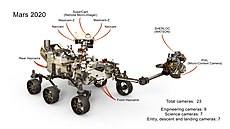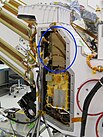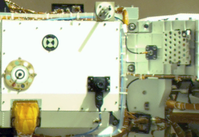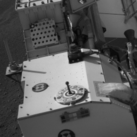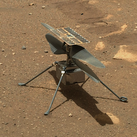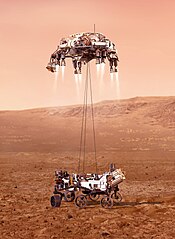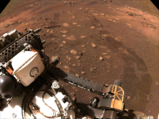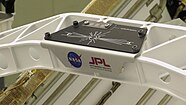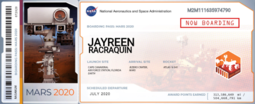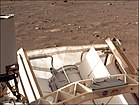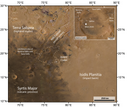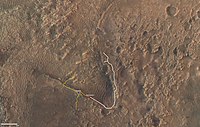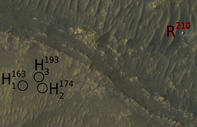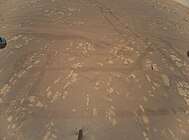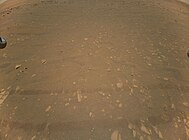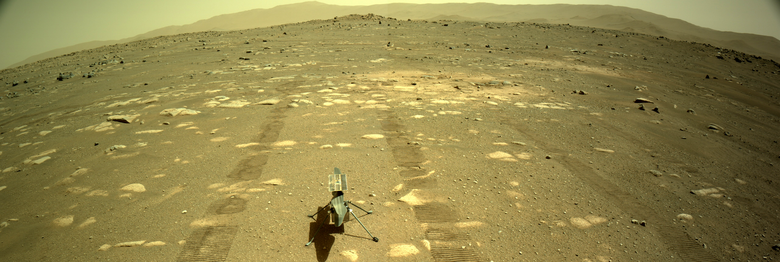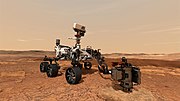Perseverance(rover)
| Perseverance | |
|---|---|
| Part ofMars 2020 | |
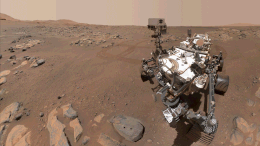 Self-portraitbyPerseverancein September 2021 at Rochette, a rock and the site of the firstcore samplesof the Mars 2020 mission. | |
| Type | Mars rover |
| Owner | NASA |
| Manufacturer | Jet Propulsion Laboratory |
| Specifications | |
| Dimensions | 2.9 m × 2.7 m × 2.2 m (9 ft 6 in × 8 ft 10 in × 7 ft 3 in) |
| Dry mass | 1,025 kilograms (2,260 lb) |
| Communication | |
| Power | MMRTG;110watt |
| Rocket | Atlas V 541 |
| Instruments | |
| History | |
| Launched |
|
| Deployed |
|
| Location | 18°26′49″N77°24′07″E/ 18.447°N 77.402°E Jezero crater,Mars |
| Travelled | 27.33 km (16.98 mi) as of 24 June 2024[update][1] |
| NASAMars rovers | |
Perseverance,nicknamedPercy,[2]is acar-sizedMars roverdesigned to explore theJezero crateronMarsas part ofNASA'sMars 2020mission. It was manufactured by theJet Propulsion Laboratoryand launched on July 30, 2020, at 11:50UTC.[3]Confirmation that the rover successfully landed on Mars was received on February 18, 2021, at 20:55 UTC.[4][5]As of 16 July 2024,Perseverancehas been active on Mars for 1210sols(1,244Earth days,or 3 years, 4 months and 28 days) since its landing. Following the rover's arrival, NASA named the landing siteOctavia E. Butler Landing.[6][7]
Perseverancehas a similar design to its predecessor rover,Curiosity,although it was moderately upgraded. It carries seven primary payload instruments, nineteen cameras, and two microphones.[8]
The rover also carried the mini-helicopterIngenuityto Mars, an experimental technology testbed that made the first powered aircraft flight on another planet on April 19, 2021.[9]On January 18, 2024 (UTC), it made its72nd and final flight,suffering damage on landing to its rotor blades, possibly all four, causing NASA to retire it.[10][11]
The rover's goals include identifying ancient Martian environments capable of supporting life, seeking out evidence of formermicrobial lifeexisting in those environments, collecting rock and soil samples to store on the Martian surface, and testingoxygenproduction from theMartian atmosphereto prepare forfuture crewed missions.[12]
Mission[edit]
Despite the high-profile success of theCuriosityroverlanding in August 2012, NASA's Mars Exploration Program was in a state of uncertainty in the early 2010s. Budget cuts forced NASA to pull out of a planned collaboration with theEuropean Space Agencywhich included a rover mission.[13]By the summer of 2012, a program that had been launching a mission to Mars every two years suddenly found itself with no missions approved after 2013.[14]
In 2011, thePlanetary Science Decadal Survey,a report from theNational Academies of Sciences, Engineering, and Medicinecontaining an influential set of recommendations made by the planetary science community, stated that the top priority of NASA's planetary exploration program in the decade between 2013 and 2022 should be to begin aNASA-ESA Mars Sample Returncampaign, a four-mission project to cache, retrieve, launch, and safely return samples of the Martian surface to Earth. The report stated that NASA should invest in a sample-caching rover as the first step in this effort, with the goal of keeping costs under US$2.5 billion.[15]
After the success of theCuriosityrover and in response to the recommendations of the decadal survey,NASAannounced its intent to launch a new Mars rover mission by 2020 at theAmerican Geophysical Unionconference in December 2012.[16]
Though initially hesitant to commit to an ambitious sample-caching capability (and subsequent follow-on missions), a NASA-convened science definition team for the Mars 2020 project released a report in July 2013 that the mission should "select and store a compelling suite of samples in a returnable cache."[17]
Science objectives[edit]
ThePerseverancerover has four main science objectives[18]that support theMars Exploration Program's science goals:[12]
- Looking for habitability: identify past environments that were capable of supportingmicrobial life.
- Seekingbiosignatures:seek signs of possible past microbial life in those habitable environments, particularly in specific rock types known to preserve signs over time.
- Caching samples: collect core rock andregolith(unconsolidated and loose "soil" ) samples and store them within the rover and on theMartian surface(as a backup) for delivery to a future sample return rocket.[19]
- Preparing for humans: testoxygenproduction from theMartian atmosphere.
In the first science campaignPerseveranceperforms an arching drive southward from its landing site to the Séítah unit to perform a "toe dip" into the unit to collect remote-sensing measurements of geologic targets. After that it will return to the Crater Floor Fractured Rough to collect the first core sample there. Passing by the Octavia E. Butler landing site concludes the first science campaign.
The second campaign will include several months of travel towards the "Three Forks" wherePerseverancecan access geologic locations at the base of the ancient delta of Neretva river, as well as ascend the delta by driving up a valley wall to the northwest.[20]
Design[edit]

ThePerseverancedesign evolved from its predecessor, theCuriosityrover.The two rovers share a similar body plan, landing system, cruise stage, and power system, but the design was improved in several ways forPerseverance.Engineers designed the rover wheels to be more robust thanCuriosity'swheels, which hadsustained some damage.[21]Perseverancehas thicker, more durablealuminumwheels, with reduced width and a greater diameter, 52.5 cm (20.7 in), thanCuriosity's50 cm (20 in) wheels.[22][23]The aluminum wheels are covered with cleats for traction and curvedtitaniumspokes for springy support.[24]Theheat shieldfor the rover was made out ofphenolic-impregnated carbon ablator(PICA), to allow it to withstand up to 2,400 °F (1,320 °C) of heat.[25]LikeCuriosity,the rover includes arobotic arm,althoughPerseverance's arm is longer and stronger, measuring 2.1 m (6 ft 11 in). The arm hosts an elaboraterock-coringand sampling mechanism to store geologic samples from the Martian surface insterilecaching tubes.[26]There is also a secondary arm hidden below the rover that helps store the chalk-sized samples. This arm is known as the Sample Handling Assembly (SHA), and is responsible for moving the soil samples to various stations within the Adaptive Caching Assembly (ACA) on the underside of the rover. These stations include volume assessment(measuring the length of sample), imaging, seal dispensing, and hermetic seal station, among others.[27]Owing to the small space in which the SHA must operate, as well as load requirements during sealing activities, the Sample Caching System "is the most complicated, most sophisticated mechanism that we have ever built, tested and readied for spaceflight."[28]
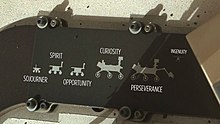
The combination of larger instruments, new sampling and caching system, and modified wheels makesPerseveranceheavier, weighing 1,025 kg (2,260 lb) compared toCuriosityat 899 kg (1,982 lb)—a 14% increase.[30]
The rover'smulti-mission radioisotope thermoelectric generator(MMRTG) has a mass of 45 kg (99 lb) and uses 4.8 kg (11 lb) ofplutonium-238oxideas its power source. The radioactive decay of plutonium-238, which has ahalf-lifeof 87.7 years, gives off heat which isconverted to electricity—approximately 110wattsat launch.[31]This will decrease over time as its power source decays.[31]The MMRTG charges twolithium-ion rechargeable batterieswhich power the rover's activities, and must be recharged periodically. Unlikesolar panels,the MMRTG provides engineers with significant flexibility in operating the rover's instruments even at night, duringdust storms,and through winter.[31]
The rover's computer uses the BAE SystemsRAD750radiation-hardenedsingle board computer based on a ruggedizedPowerPC G3 microprocessor (PowerPC 750).The computer contains 128 megabytes of volatileDRAM,and runs at 133 MHz. The flight software runs on theVxWorksoperating system,is written inCand is able to access 4 gigabytes ofNAND non-volatile memoryon a separate card.[32]Perseverancerelies on three antennas fortelemetry,all of which are relayed through craft currently in orbit around Mars. The primaryUHFantenna can send data from the rover at a maximum rate of two megabits per second.[33]Two slowerX-bandantennas provide communications redundancy.
Instruments[edit]
NASA considered nearly 60 proposals[35][36]for rover instrumentation. On July 31, 2014, NASA announced the seven instruments that would make up the payload for the rover:[37][38]
- Mars Oxygen ISRU Experiment(MOXIE), an exploration technology investigation to produce a small amount ofoxygen(O2) from Martian atmosphericcarbon dioxide(CO2). On April 20, 2021, 5.37 grams of oxygen were produced in an hour, with nine more extractions planned over the course of two Earth years to further investigate the instrument.[39]This technology could be scaled up in the future for human life support or to make the rocket fuel for return missions.[40][41]
- Planetary Instrument for X-Ray Lithochemistry(PIXL), anX-ray fluorescencespectrometerto determine the fine scale elemental composition of Martian surface materials.[42][43][44]
- Radar Imager for Mars' subsurface experiment(RIMFAX), aground-penetrating radarto image different ground densities, structural layers, buried rocks, meteorites, and detectunderground water iceand saltybrineat 10 m (33 ft) depth. The RIMFAX is being provided by theNorwegian Defence Research Establishment(FFI).[45][46][47][48]
- Mars Environmental Dynamics Analyzer(MEDA), a set of sensors that measure temperature, wind speed and direction, pressure, relative humidity, radiation, and dust particle size and shape. It is provided bySpain'sCentro de Astrobiología.[49]
- SuperCam,an instrument suite that can provide imaging, chemical composition analysis, and mineralogy in rocks andregolithfrom a distance. It is an upgraded version of theChemCamon theCuriosityrover but with two lasers and four spectrometers that will allow it to remotely identifybiosignaturesand assess the past habitability. SuperCam is used in conjunction with theAEGIStargeting system.Los Alamos National Laboratory,the Research Institute in Astrophysics and Planetology (IRAP) inFrance,the French Space Agency (CNES), theUniversity of Hawaii,and theUniversity of ValladolidinSpaincooperated in the SuperCam's development and manufacture.[50][51]
- Mastcam-Z,a stereoscopic imaging system with the ability to zoom.[52][53]Many photos were included in the publishedNASA photogallery.(IncludingRaw)
- Scanning Habitable Environments with Raman and Luminescence for Organics and Chemicals(SHERLOC), anultravioletRaman spectrometerthat uses fine-scale imaging and an ultraviolet (UV) laser to determine fine-scale mineralogy and detectorganic compounds.[54][55]
There are additional cameras and two audio microphones (the first working microphones on Mars), that will be used for engineering support during landing,[56]driving, and collecting samples.[57][58]For a full look atPerseverance's components seeLearn About the Rover.
MarsIngenuityhelicopter experiment[edit]
TheIngenuityhelicopter, powered by solar-charged batteries, was sent to Mars in the same bundle withPerseverance.With a mass of 1.8 kg (4.0 lb), the helicopter demonstrated the reality of flight in the rarefiedMartian atmosphereand the potential usefulness of aerial scouting for rover missions. It carried two cameras but no scientific instruments[59][60][61]and communicated with Earth via a base station onboardPerseverance.[62]Its pre-launch experimental test plan was three flights in 45 days, but it far exceeded expectations and made72 flightsin nearly three years. After its first few flights, it made incrementally more ambitious ones, several of which were recorded byPerseverance's cameras. The first flight was April 19, 2021, at 07:15 UTC, with confirmation from data reception at 10:15 UTC.[63][64][65][66][67]It was the first powered flight by any aircraft on another planet.[9]On January 18, 2024 (UTC), it made its72nd and final flight,suffering damage to its rotor blades on landing, causing NASA to retire it.[10]
Name[edit]

Associate Administrator ofNASA's Science Mission Directorate,Thomas Zurbuchenselected the namePerseverancefollowing a nationwideK-12student "name the rover" contest that attracted more than 28,000 proposals. Aseventh-gradestudent, Alexander Mather fromLake Braddock Secondary SchoolinBurke, Virginia,submitted the winning entry at theJet Propulsion Laboratory.In addition to the honor of naming the rover, Mather and his family were invited to NASA'sKennedy Space Centerto watch the rover's July 2020 launch fromCape Canaveral Air Force Station(CCAFS) inFlorida.[68]
Mather wrote in his winning essay:
Curiosity. InSight. Spirit. Opportunity. If you think about it, all of these names of past Mars rovers are qualities we possess as humans. We are always curious, and seek opportunity. We have the spirit and insight to explore the Moon, Mars, and beyond. But, if rovers are to be the qualities of us as a race, we missed the most important thing. Perseverance. We as humans evolved as creatures who could learn to adapt to any situation, no matter how harsh. We are a species of explorers, and we will meet many setbacks on the way to Mars. However, we can persevere. We, not as a nation but as humans, will not give up. The human race will always persevere into the future.[68]
Twin rover[edit]
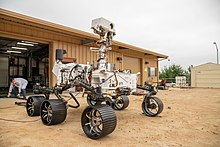
JPL built a copy of thePerseverance;a twin rover used for testing and problem solving,OPTIMISM(Operational Perseverance Twin for Integration of Mechanisms and Instruments Sent to Mars), a vehicle system test bed (VSTB). It is housed at the JPLMars Yardand is used to test operational procedures and to aid in problem solving should any issues arise withPerseverance.[69]
Operational history[edit]
Mars transit[edit]
ThePerseverancerover lifted off successfully on July 30, 2020, at 11:50:00 UTC aboard aUnited Launch AllianceAtlas Vlaunch vehiclefromSpace Launch Complex 41,atCape Canaveral Air Force Station(CCAFS) inFlorida.[70]
The rover took 29 weeks to travel to Mars and made its landing inJezero Crateron February 18, 2021, to begin its science phase.[71]
After May 17, 2022, the rover will move uphill and examine rocks on the surface for evidence of past life onMars.On its return downhill, it will collect sample rocks to be retrieved and examined by future expeditions.[72]
Landing[edit]
(February 2021)
The successful landing ofPerseveranceinJezero Craterwas announced at 20:55 UTC on February 18, 2021,[4]the signal from Mars taking 11 minutes to arrive at Earth. The rover touched down at18°26′41″N77°27′03″E/ 18.4446°N 77.4509°E,[73]roughly 1 km (0.62 mi) southeast of the center of its 7.7 km × 6.6 km (4.8 mi × 4.1 mi)[74]wide landing ellipse. It came down pointed almost directly to the southeast,[75]with the RTG on the back of the vehicle pointing northwest. The descent stage ( "sky crane"), parachute and heat shield all came to rest within 1.5 km of the rover (see satellite image). Having come within sixteen feet (~5 meters) of its target, the landing was more accurate than any previous Mars landing; a feat enabled by the experience gained fromCuriosity's landing and the use of new steering technology.[74]
One such new technology is Terrain Relative Navigation (TRN), a technique in which the rover compares images of the surface taken during its descent with reference maps, allowing it to make last minute adjustments to its course. The rover also uses the images to select a safe landing site at the last minute, allowing it to land in relatively unhazardous terrain. This enables it to land much closer to its science objectives than previous missions, which all had to use a landing ellipse devoid of hazards.[74]
The landing occurred in the late afternoon, with the first images taken at 15:53:58 on themission clock(local mean solar time).[76]The landing took place shortly after Mars passed through itsnorthern vernal equinox(Ls= 5.2°), at the start of the astronomical spring, the equivalent of the end of March on Earth.[77]
The parachute descent of thePerseverancerover was photographed by theHiRISEhigh-resolution camera on theMars Reconnaissance Orbiter(MRO).[78]
Jezero Crater is a paleolake basin.[79][80]It was selected as the landing site for this mission in part because paleolake basins tend to containperchlorates.[79][80]AstrobiologistDr. Kennda Lynch'swork in analog environments on Earth suggests that the composition of the crater, including the bottomset deposits accumulated from three different sources in the area, is a likely place to discover evidence of perchlorate-reducing microbes, if such bacteria are living or were formerly living on Mars.[79][80]
-
Video ofPerseverance's parachute deployment and powered landing sequence
-
Perseveranceparachute descent over the Jezero crater photographed byMars Reconnaissance Orbiter(MRO)
-
An illustration ofPerseverancetethered to thesky crane.
-
The rover photographed from the sky crane during descent
A few days after landing,Perseverancereleased the first audio recorded on the surface of Mars, capturing the sound of Martianwind.[81][82]
During its travels on Mars, NASA scientists had observed around Sol 341 (February 4, 2022) that a small rock had dropped into one of its wheels while the rover was studying the Máaz rock formation. The rock was visible from one of the hazard avoidance cameras, and was determined not to be harmful to the rover's mission. The rock has since stayed onPerseverance's wheels for at least 123 sols (126 days) as the rover traveled over 5 miles (8.0 km) on the surface. NASA deemed thatPerseverancehad adopted apet rockfor its journey.[83][84]
Traverse[edit]

It is planned forPerseveranceto visit the bottom and upper parts of the 3.4 to 3.8 billion-year-oldNeretva Vallisdelta, the smooth and etched parts of the Jezero Crater floor deposits interpreted as volcanic ash or aeolian airfall deposits, emplaced before the formation of the delta; the ancient shoreline covered withTransverse Aeolian Ridges(dunes) and mass wasting deposits, and finally, it is planned to climb onto the Jezero Crater rim.[86]
In its progressive commissioning and tests,Perseverancemade its first test drive on Mars on March 4, 2021. NASA released photographs of the rover's first wheel tracks on the Martian soil.[87]
Samples cached for the Mars sample-return mission[edit]
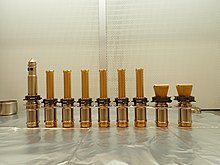
- The pointed one with two windows on the left is the regolith drill
- the two shorter ones on the right are abrasion tools
- the others in the center are rock drills
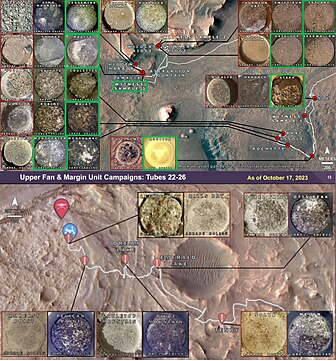
In support of theNASA-ESA Mars Sample Return,rock,regolith(Martian soil), and atmosphere samples are being cached byPerseverance.As of October 2023, 27 out of 43 sample tubes have been filled,[88]including 8 igneous rock samples, 12 sedimentary rock sample tubes, aSilica-cementedcarbonate rocksample tube,[89]two regolith sample tubes, an atmosphere sample tube,[90]and three witness tubes.[91]Before launch, 5 of the 43 tubes were designated "witness tubes" and filled with materials that would capture particulates in the ambient environment of Mars. Out of 43 tubes, 3 witness sample tubes will not be returned to Earth and will remain on rover as the sample canister will only have 30 tube slots. Further, 10 of the 43 tubes are left as backups at the Three Forks Sample Depot.[92]
Cost[edit]
NASA plans to invest roughly US$2.75 billion in the project over 11 years, including US$2.2 billion for the development and building of the hardware, US$243 million for launch services, and US$291 million for 2.5 years of mission operations.[8][93]
Adjusted for inflation,Perseveranceis NASA's sixth-most expensive robotic planetary mission, though it is cheaper than its predecessor,Curiosity.[94]Perseverancebenefited from spare hardware and "build-to print" designs from theCuriositymission, which helped reduce development costs and saved "probably tens of millions, if not 100 million dollars" according to Mars 2020 Deputy Chief Engineer Keith Comeaux.[95]
Commemorative artifacts[edit]
"Send Your Name to Mars"[edit]
NASA's "Send Your Name to Mars" campaign invited people from around the world to submit their names to travel aboard the agency's next rover to Mars. 10,932,295 names were submitted. The names were etched by an electron beam onto three fingernail-sizedsiliconchips, along with the essays of the 155 finalists in NASA's "Name the Rover" contest. The three chips share space on an anodized plate with a laser engraved graphic representing Earth, Mars, and the Sun. The rays emanating from the Sun contain the phrase "Explore As One" written inMorse code.[96]The plate was then mounted on the rover on March 26, 2020.[97]
(March 26, 2020)
(February 28, 2021)
Geocaching in Space Trackable[edit]

Part ofPerseverance's cargo is ageocachingtrackable item viewable with the SHERLOC's WATSON camera.[98]
In 2016, NASA SHERLOC co-investigator Dr. Marc Fries — with help from his son Wyatt — was inspired by Geocaching's 2008 placement of a cache on the International Space Station to set out and try something similar with the rover mission. After floating the idea around mission management, it eventually reached NASA scientist Francis McCubbin, who would join the SHERLOC instrument team as a collaborator to move the project forward. The Geocaching inclusion was scaled-down to a trackable item that players could search for from NASA camera views and then log on to the site.[99]In a manner similar to the "Send Your Name to Mars" campaign, the geocaching trackable code was carefully printed on a one-inch, polycarbonate glass disk serving as part of the rover's calibration target. It will serve as an optical target for the WATSON imager and a spectroscopic standard for the SHERLOC instrument. The disk is made of a prototype astronaut helmet visor material that will be tested for its potential use in crewed missions to Mars. Designs were approved by the mission leads at NASA'sJet Propulsion Laboratory(JPL), NASA Public Affairs, and NASA HQ, in addition to Groundspeak Geocaching HQ.[100][101]
Tribute to healthcare workers[edit]

Perseverancelaunched during theCOVID-19 pandemic,which began to affect the mission planning in March 2020. To show appreciation for healthcare workers who helped during the pandemic, an 8 cm × 13 cm (3.1 in × 5.1 in) plate with astaff-and-serpent symbol(aGreeksymbol of medicine) was placed on the rover. The project manager, Matt Wallace, said he hoped that future generations going to Mars would be able to appreciate healthcare workers during 2020.[102]
Family portrait of NASA Mars rovers[edit]
One of the external plates ofPerseveranceincludes a simplified representation of all previous NASA Martian rovers,Sojourner,Spirit,Opportunity,Curiosity,as well asPerseveranceandIngenuity,similar to the trend of automobile window decals used to show a family's makeup.[103]
Parachute with coded message[edit]

The orange-and-white parachute used to land the rover on Mars contained a coded message that was deciphered by Twitter users. NASA's systems engineer Ian Clark used binary code to hide the message "dare mighty things" in the parachute color pattern. The 70-foot-wide (21 m) parachute consisted of 80 strips of fabric that form a hemisphere-shape canopy, and each strip consisted of four pieces. Dr. Clark thus had 320 pieces with which to encode the message. He also included theGPScoordinates for the Jet Propulsion Laboratory's headquarters inPasadena, California(34°11’58” N 118°10’31” W). Clark said that only six people knew about the message before landing. The code was deciphered a few hours after the image was presented byPerseverance's team.[104][105][106]
"Dare mighty things" is a quote attributed to U.S. presidentTheodore Rooseveltand is the unofficial motto of the Jet Propulsion Laboratory.[107]It adorns many of theJPL center'swalls.
NASA outreach to students[edit]
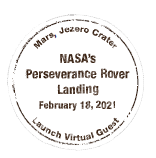
In December 2021, the NASA team announced a program to students who haveperseveredwith academic challenges. Those nominated will be rewarded with a personal message beamed back from Mars by thePerseverancerover.

(December 9, 2021)
Gallery[edit]
(February 2021)
R210is the rover position on sol 210;
H163
1,H174
2andH193
3means 1st, 2nd and 3rd landing sites ofIngenuityon the FieldHon sols 163, 174 and 193 respectively
March 5, 2024:NASA released images of transits of the moonDeimos,the moonPhobosand the planet Mercury as viewed by thePerseverancerover on the planet Mars.

Notes[edit]
- ^Note the difference: the twin rover on Earth is powered by electric cables, whilePerseveranceon Mars is powered by amulti-mission radioisotope thermoelectric generator(MMRTG).
- ^Aerial image byIngenuity
See also[edit]
References[edit]
- ^"Where is Perseverance?".NASA Science.NASA.RetrievedJune 24,2024.
- ^Landers, Rob (February 17, 2021)."It's landing day! What you need to know about Perseverance Rover's landing on Mars".Florida Today.Archivedfrom the original on February 19, 2021.RetrievedFebruary 19,2021.
- ^"Launch Windows".mars.nasa.gov.NASA.Archivedfrom the original on July 31, 2020.RetrievedJuly 28,2020.
 This article incorporates text from this source, which is in thepublic domain.
This article incorporates text from this source, which is in thepublic domain.
- ^abmars.nasa.gov."Touchdown! NASA's Mars Perseverance Rover Safely Lands on Red Planet".NASA.Archivedfrom the original on February 20, 2021.RetrievedFebruary 18,2021.
 This article incorporates text from this source, which is in thepublic domain.
This article incorporates text from this source, which is in thepublic domain.
- ^Overbye, Dennis (February 19, 2021)."Perseverance's Pictures From Mars Show NASA Rover's New Home – Scientists working on the mission are eagerly scrutinizing the first images sent back to Earth by the robotic explorer".The New York Times.Archivedfrom the original on February 19, 2021.RetrievedFebruary 19,2021.
- ^NASA's Perseverance Drives on Mars' Terrain for First TimeArchivedMarch 6, 2021, at theWayback MachineNASA, March 5, 2021.
- ^Staff (March 5, 2021)."Welcome to 'Octavia E. Butler Landing'".NASA.Archivedfrom the original on March 5, 2021.RetrievedMarch 5,2021.
- ^ab"Mars Perseverance Landing Press Kit"(PDF).Jet Propulsion Laboratory.NASA.Archived(PDF)from the original on February 18, 2021.RetrievedFebruary 17,2021.
 This article incorporates text from this source, which is in thepublic domain.
This article incorporates text from this source, which is in thepublic domain.
- ^abChang, Kenneth (April 19, 2021)."NASA's Mars Helicopter Achieves First Flight on Another World – The experimental Ingenuity vehicle completed the short but historic up-and-down flight on Monday morning".The New York Times.Archived fromthe originalon December 28, 2021.RetrievedApril 19,2021.
- ^ab"After Three Years on Mars, NASA's Ingenuity Helicopter Mission Ends".Jet Propulsion Laboratory.
- ^NASA Science Live: Ingenuity Mars Helicopter Tribute & Legacy,January 31, 2024,retrievedFebruary 1,2024
- ^ab"Overview".mars.nasa.gov.NASA.Archivedfrom the original on June 8, 2019.RetrievedOctober 6,2020.
 This article incorporates text from this source, which is in thepublic domain.
This article incorporates text from this source, which is in thepublic domain.
- ^"Europe To Press Ahead with ExoMars Plans Without NASA".SpaceNews. February 13, 2012.
- ^Kremer, Ken (February 11, 2012)."Budget Axe to Gore America's Future Exploration of Mars and Search for Martian Life".Universe Today.Archivedfrom the original on November 29, 2020.RetrievedFebruary 17,2021.
- ^Vision and Voyages for Planetary Science in the Decade 2013–2022.National Research Council. March 7, 2011.doi:10.17226/13117.ISBN978-0-309-22464-2.Archivedfrom the original on February 11, 2021.RetrievedFebruary 17,2021.
 This article incorporates text from this source, which is in thepublic domain.
This article incorporates text from this source, which is in thepublic domain.
- ^Wall, Mike (December 4, 2012)."NASA to Launch New Mars Rover in 2020".SPACE.Archivedfrom the original on November 11, 2017.RetrievedDecember 5,2012.
- ^Mustard, J.F.; Adler, M.; Allwood, A.; et al. (July 1, 2013)."Report of the Mars 2020 Science Definition Team"(PDF).Mars Exploration Program Anal. Gr.NASA.Archived(PDF)from the original on October 20, 2020.RetrievedFebruary 17,2021.
 This article incorporates text from this source, which is in thepublic domain.
This article incorporates text from this source, which is in thepublic domain.
- ^"Objectives".2020 Mission Perseverance Rover.NASA.RetrievedSeptember 29,2021.
- ^NASA [@NASAPersevere] (December 23, 2022)."Some of you are wondering about the samples..."(Tweet).RetrievedJanuary 5,2023– viaTwitter.
- ^Perseverance's First Road Trip
- ^Lakdawalla, Emily (August 19, 2014)."Curiosity wheel damage: The problem and solutions".planetary.org.The Planetary Society.Archivedfrom the original on May 26, 2020.RetrievedAugust 22,2014.
- ^Wehner, Mike (April 7, 2020)."NASA's Perseverance rover got some sweet new wheels".BGR.Archivedfrom the original on February 27, 2021.RetrievedFebruary 27,2021.
- ^"Mars 2020 – Body: New Wheels for Mars 2020".NASA/JPL.Archivedfrom the original on July 26, 2019.RetrievedJuly 6,2018.
 This article incorporates text from this source, which is in thepublic domain.
This article incorporates text from this source, which is in thepublic domain.
- ^"Mars 2020 Rover – Wheels".NASA.Archivedfrom the original on June 29, 2019.RetrievedJuly 9,2018.
 This article incorporates text from this source, which is in thepublic domain.
This article incorporates text from this source, which is in thepublic domain.
- ^Meyer, Mal (February 19, 2021)."Biddeford company creates critical part for Mars rover 'Perseverance' to land safely".WGME.RetrievedApril 22,2021.
- ^"Mars 2020 Rover's 7-Foot-Long Robotic Arm Installed".mars.nasa.gov.June 28, 2019.Archivedfrom the original on December 5, 2020.RetrievedJuly 1,2019.
The main arm includes five electrical motors and five joints (known as the shoulder azimuth joint, shoulder elevation joint, elbow joint, wrist joint and turret joint). Measuring 7 feet (2.1 meters) long, the arm will allow the rover to work as a human geologist would: by holding and using science tools with its turret, which is essentially its hand.
 This article incorporates text from this source, which is in thepublic domain.
This article incorporates text from this source, which is in thepublic domain.
- ^"Inside Perseverance: How Maxar Robotics Will Enable a Historic Mars…".
- ^"The Extraordinary Sample-Gathering System of NASA's Perseverance Mars".June 2, 2020.
- ^abcdStaff (2021)."Messages on Mars Perseverance Rover".NASA.Archivedfrom the original on March 2, 2021.RetrievedMarch 7,2021.
- ^"NASAfacts: Mars 2020/Perseverance"(PDF).July 26, 2020. Archived fromthe original(PDF)on July 26, 2020.RetrievedAugust 13,2020.
 This article incorporates text from this source, which is in thepublic domain.
This article incorporates text from this source, which is in thepublic domain.
- ^abc"Mars 2020 Rover Tech Specs".JPL/NASA.Archivedfrom the original on July 26, 2019.RetrievedJuly 6,2018.
 This article incorporates text from this source, which is in thepublic domain.
This article incorporates text from this source, which is in thepublic domain.
- ^"Prototyping an Onboard Scheduler for the Mars 2020 Rover"(PDF).NASA.Archived(PDF)from the original on February 18, 2021.RetrievedJuly 30,2020.
 This article incorporates text from this source, which is in thepublic domain.
This article incorporates text from this source, which is in thepublic domain.
- ^"Communications".NASA.Archivedfrom the original on January 28, 2021.RetrievedFebruary 2,2021.
- ^"Sounds of Perseverance Mars Rover Driving – Sol 16 (16 minutes)".nasa.gov.National Aeronautics and Space Administration.Archivedfrom the original on March 20, 2021.RetrievedOctober 1,2021.
- ^Webster, Guy; Brown, Dwayne (January 21, 2014)."NASA Receives Mars 2020 Rover Instrument Proposals for Evaluation".NASA.Archivedfrom the original on November 12, 2020.RetrievedJanuary 21,2014.
 This article incorporates text from this source, which is in thepublic domain.
This article incorporates text from this source, which is in thepublic domain.
- ^Timmer, John (July 31, 2014)."NASA announces the instruments for the next Mars rover".Ars Technica.Archivedfrom the original on January 20, 2015.RetrievedMarch 7,2015.
- ^Brown, Dwayne (July 31, 2014)."Release 14-208 – NASA Announces Mars 2020 Rover Payload to Explore the Red Planet as Never Before".NASA.Archivedfrom the original on April 1, 2019.RetrievedJuly 31,2014.
 This article incorporates text from this source, which is in thepublic domain.
This article incorporates text from this source, which is in thepublic domain.
- ^Brown, Dwayne (July 31, 2014)."NASA Announces Mars 2020 Rover Payload to Explore the Red Planet as Never Before".NASA.Archivedfrom the original on March 5, 2016.RetrievedJuly 31,2014.
 This article incorporates text from this source, which is in thepublic domain.
This article incorporates text from this source, which is in thepublic domain.
- ^Potter, Sean (April 21, 2021)."NASA's Perseverance Mars Rover Extracts First Oxygen from Red Planet".NASA.RetrievedApril 22,2021.
- ^Jet Propulsion Laboratory (JPL)."Mars Oxygen In-Situ Resource Utilization Experiment (MOXIE)".techport.nasa.gov.NASA.Archivedfrom the original on October 17, 2020.RetrievedDecember 28,2019.
 This article incorporates text from this source, which is in thepublic domain.
This article incorporates text from this source, which is in thepublic domain.
- ^Hecht, M.; Hoffman, J.; Rapp, D.; McClean, J.; SooHoo, J.; Schaefer, R.; Aboobaker, A.; Mellstrom, J.; Hartvigsen, J.; Meyen, F.; Hinterman, E. (2021)."Mars Oxygen ISRU Experiment (MOXIE)".Space Science Reviews.217(1): 9.Bibcode:2021SSRv..217....9H.doi:10.1007/s11214-020-00782-8.hdl:1721.1/131816.2.ISSN0038-6308.S2CID106398698.RetrievedMarch 9,2021.
- ^Webster, Guy (July 31, 2014)."Mars 2020 Rover's PIXL to Focus X-Rays on Tiny Targets".NASA.Archivedfrom the original on June 22, 2020.RetrievedJuly 31,2014.
 This article incorporates text from this source, which is in thepublic domain.
This article incorporates text from this source, which is in thepublic domain.
- ^"Adaptive sampling for rover x-ray lithochemistry"(PDF).David Ray Thompson. Archived fromthe original(PDF)on August 8, 2014.
- ^Allwood, Abigail C.; Wade, Lawrence A.; Foote, Marc C.; Elam, William Timothy; Hurowitz, Joel A.; Battel, Steven; Dawson, Douglas E.; Denise, Robert W.; Ek, Eric M.; Gilbert, Martin S.; King, Matthew E. (2020)."PIXL: Planetary Instrument for X-Ray Lithochemistry".Space Science Reviews.216(8): 134.Bibcode:2020SSRv..216..134A.doi:10.1007/s11214-020-00767-7.ISSN0038-6308.S2CID229416825.Archivedfrom the original on February 27, 2021.RetrievedMarch 9,2021.
- ^"RIMFAX, The Radar Imager for Mars' Subsurface Experiment".NASA. July 2016.Archivedfrom the original on December 22, 2019.RetrievedJuly 19,2016.
 This article incorporates text from this source, which is in thepublic domain.
This article incorporates text from this source, which is in thepublic domain.
- ^Chung, Emily (August 19, 2014)."Mars 2020 rover's RIMFAX radar will 'see' deep underground".cbc.ca.Canadian Broadcasting Corp.Archivedfrom the original on September 25, 2020.RetrievedAugust 19,2014.
- ^"University of Toronto scientist to play key role on Mars 2020 Rover Mission".Archivedfrom the original on August 6, 2020.RetrievedMarch 14,2020.
- ^Hamran, Svein-Erik; Paige, David A.; Amundsen, Hans E. F.; Berger, Tor; Brovoll, Sverre; Carter, Lynn; Damsgård, Leif; Dypvik, Henning; Eide, Jo; Eide, Sigurd; Ghent, Rebecca (2020)."Radar Imager for Mars' Subsurface Experiment – RIMFAX".Space Science Reviews.216(8): 128.Bibcode:2020SSRv..216..128H.doi:10.1007/s11214-020-00740-4.hdl:10852/81406.ISSN0038-6308.
- ^"In-Situ Resource Utilization (ISRU)".Archived fromthe originalon April 2, 2015.
- ^"NASA Administrator Signs Agreements to Advance Agency's Journey to Mars".NASA. June 16, 2015.Archivedfrom the original on November 8, 2020.RetrievedMarch 14,2020.
 This article incorporates text from this source, which is in thepublic domain.
This article incorporates text from this source, which is in thepublic domain.
- ^Manrique, J. A.; Lopez-Reyes, G.; Cousin, A.; Rull, F.; Maurice, S.; Wiens, R. C.; Madsen, M. B.; Madariaga, J. M.; Gasnault, O.; Aramendia, J.; Arana, G. (2020)."SuperCam Calibration Targets: Design and Development".Space Science Reviews.216(8): 138.Bibcode:2020SSRv..216..138M.doi:10.1007/s11214-020-00764-w.ISSN0038-6308.PMC7691312.PMID33281235.
- ^Kinch, K. M.; Madsen, M. B.; Bell, J. F.; Maki, J. N.; Bailey, Z. J.; Hayes, A. G.; Jensen, O. B.; Merusi, M.; Bernt, M. H.; Sørensen, A. N.; Hilverda, M. (2020)."Radiometric Calibration Targets for the Mastcam-Z Camera on the Mars 2020 Rover Mission".Space Science Reviews.216(8): 141.Bibcode:2020SSRv..216..141K.doi:10.1007/s11214-020-00774-8.hdl:10261/234124.ISSN0038-6308.
- ^Bell, J. F.; Maki, J. N.; Mehall, G. L.; Ravine, M. A.; Caplinger, M. A.; Bailey, Z. J.; Brylow, S.; Schaffner, J. A.; Kinch, K. M.; Madsen, M. B.; Winhold, A. (2021)."The Mars 2020 Perseverance Rover Mast Camera Zoom (Mastcam-Z) Multispectral, Stereoscopic Imaging Investigation".Space Science Reviews.217(1): 24.Bibcode:2021SSRv..217...24B.doi:10.1007/s11214-020-00755-x.ISSN0038-6308.PMC7883548.PMID33612866.
- ^Webster, Guy (July 31, 2014)."SHERLOC to Micro-Map Mars Minerals and Carbon Rings".NASA.Archivedfrom the original on June 26, 2020.RetrievedJuly 31,2014.
 This article incorporates text from this source, which is in thepublic domain.
This article incorporates text from this source, which is in thepublic domain.
- ^"SHERLOC: Scanning Habitable Environments with Raman and Luminescence for Organics and Chemicals, an Investigation for 2020"(PDF).Archived(PDF)from the original on September 28, 2020.RetrievedMarch 14,2020.
- ^"Microphones on Mars 2020".NASA.Archivedfrom the original on March 29, 2019.RetrievedDecember 3,2019.
 This article incorporates text from this source, which is in thepublic domain.
This article incorporates text from this source, which is in thepublic domain.
- ^Strickland, Ashley (July 15, 2016)."New Mars 2020 rover will be able to" hear "the Red Planet".cnn.CNN News.Archivedfrom the original on October 16, 2020.RetrievedMarch 14,2020.
- ^Maki, J. N.; Gruel, D.; McKinney, C.; Ravine, M. A.; Morales, M.; Lee, D.; Willson, R.; Copley-Woods, D.; Valvo, M.; Goodsall, T.; McGuire, J. (2020)."The Mars 2020 Engineering Cameras and Microphone on the Perseverance Rover: A Next-Generation Imaging System for Mars Exploration".Space Science Reviews.216(8): 137.Bibcode:2020SSRv..216..137M.doi:10.1007/s11214-020-00765-9.ISSN0038-6308.PMC7686239.PMID33268910.
- ^"Mars mission readies tiny chopper for Red Planet flight".BBC News.August 29, 2019.Archivedfrom the original on December 5, 2020.RetrievedMarch 14,2020.
- ^Chang, Kenneth (May 12, 2018)."A Helicopter on Mars? NASA Wants to Try".The New York Times.Archivedfrom the original on December 17, 2020.RetrievedMay 12,2018.
- ^Gush, Loren (May 11, 2018)."NASA is sending a helicopter to Mars to get a bird's-eye view of the planet – The Mars Helicopter is happening, y'all".The Verge.Archivedfrom the original on December 6, 2020.RetrievedMay 11,2018.
- ^Volpe, Richard."2014 Robotics Activities at JPL"(PDF).Jet Propulsion Laboratory.NASA.Archived(PDF)from the original on February 21, 2021.RetrievedSeptember 1,2015.
 This article incorporates text from this source, which is in thepublic domain.
This article incorporates text from this source, which is in thepublic domain.
- ^First Flight of the Ingenuity Mars Helicopter: Live from Mission Control.NASA. April 19, 2021.RetrievedApril 19,2021– via YouTube.
- ^"Work Progresses Toward Ingenuity's First Flight on Mars".NASA Mars Helicopter Tech Demo.NASA. April 12, 2021.
- ^"Mars Helicopter completed full-speed spin test".Twitter.NASA. April 17, 2021.RetrievedApril 17,2021.
- ^"Mars Helicopter Tech Demo".Watch Online.NASA.April 18, 2021.RetrievedApril 18,2021.
- ^Mccurdy, Christen (April 17, 2021)."Mars Ingenuity flight scheduled for Monday, NASA says".Mars Daily.ScienceDaily.RetrievedApril 18,2021.
- ^ab"Name the Rover".mars.nasa.gov.NASA.Archivedfrom the original on November 21, 2020.RetrievedOctober 20,2020.
 This article incorporates text from this source, which is in thepublic domain.
This article incorporates text from this source, which is in thepublic domain.
- ^Amanda Kooser (September 5, 2020)."NASA's Perseverance Mars rover has an Earth twin named Optimism".C/Net.Archivedfrom the original on November 28, 2020.RetrievedFebruary 25,2021.
- ^Drake, Nadia(July 30, 2020)."NASA's newest Mars rover begins its journey to hunt for alien life".nationalgeographic.National Geographic. Archived fromthe originalon July 30, 2020.RetrievedJuly 30,2020.
- ^"Mission Timeline > Cruise".mars.nasa.gov.NASA.Archivedfrom the original on January 20, 2021.RetrievedJanuary 20,2021.
 This article incorporates text from this source, which is in thepublic domain.
This article incorporates text from this source, which is in thepublic domain.
- ^"Perseverance: Nasa rover begins key drive to find life on Mars".BBC News.May 17, 2022.RetrievedMay 19,2022.
- ^"Perseverance Rover Landing Site Map".mars.nasa.gov.NASA.Archivedfrom the original on February 22, 2021.RetrievedFebruary 19,2021.
 This article incorporates text from this source, which is in thepublic domain.
This article incorporates text from this source, which is in thepublic domain.
- ^abcMehta, Jatan (February 17, 2021)."How NASA Aims to Achieve Perseverance's High-Stakes Mars Landing".Scientific American.Archivedfrom the original on February 26, 2021.RetrievedFebruary 25,2021.
- ^"Al Chen, at 26:11, of NASA Press Conference Transcript February 22: Perseverance Rover Searches for Life on Mars".Rev.February 22, 2021.Archivedfrom the original on March 2, 2021.RetrievedFebruary 27,2021.
- ^NASA/JPL-Caltech (February 18, 2021)."Images from the Mars Perseverance Rover – Mars Perseverance Sol 0: Front Left Hazard Avoidance Camera (Hazcam)".mars.nasa.gov.Archivedfrom the original on February 26, 2021.RetrievedFebruary 25,2021.
- ^Lakdawalla, Emily (January 28, 2021)."Coming Soon: Perseverance Sol 0".Patreon.
- ^"HiRISE Captured Perseverance During Descent to Mars".NASA.February 19, 2021.Archivedfrom the original on February 22, 2021.RetrievedFebruary 25,2021.
- ^abcSmith, Yvette (February 2, 2021)."Astrobiologist Kennda Lynch Uses Analogs on Earth to Find Life on Mars"ArchivedMarch 1, 2021, at theWayback Machine.NASA.Retrieved 2021-03-02.
- ^abcDaines, Gary (August 14, 2020)."Season 4, Episode 15 Looking For Life in Ancient Lakes".ArchivedFebruary 19, 2021, at theWayback MachineGravity Assist.NASA. Podcast. Retrieved 2021-03-02.
- ^Strickland, Ashley (February 23, 2021)."NASA shares first video and audio, new images from Mars Perseverance rover".CNN.RetrievedMay 2,2021.
- ^Crane, Leah (February 22, 2021)."Perseverance rover has sent back stunning video and audio from Mars".New Scientist.RetrievedMay 2,2021.
- ^Ravanis, Eleni (June 2, 2022)."Perseverance Has a Pet Rock!".NASA.RetrievedJune 10,2022.
- ^Marples, Megan (June 9, 2022)."Perseverance rover has made a friend on Mars".CNN.RetrievedJune 10,2022.
- ^„Where is the rover”
- ^Erik Klemetti (February 18, 2021)."Jezero Crater: Perseverance rover will soon explore geology of ancient crater lake".Astronomy.RetrievedJune 22,2021.
- ^mars.nasa.gov (March 5, 2021)."Perseverance Is Roving on Mars – NASA's Mars Exploration Program".NASA’s Mars Exploration Program.Archivedfrom the original on March 6, 2021.RetrievedMarch 6,2021.
- ^mars.nasa.gov."Perseverance Rover Mars Rock Samples".NASA Mars Exploration.Archived fromthe originalon November 11, 2022.RetrievedDecember 25,2023.
- ^"Nobody Tell Elmo About Issole".nasa.gov.RetrievedFebruary 11,2022.
- ^mars.nasa.gov (August 26, 2021)."NASA's Perseverance Plans Next Sample Attempt".NASA’s Mars Exploration Program.RetrievedAugust 27,2021.
- ^"Sample Caching Dry Run, 1st sample tube cached".Twitter.RetrievedAugust 27,2021.
- ^mars.nasa.gov."Perseverance Sample Tube 266".NASA’s Mars Exploration Program.RetrievedSeptember 9,2021.
- ^"Cost of Perseverance".The Planetary Society.Archivedfrom the original on February 18, 2021.RetrievedFebruary 17,2021.
- ^"The Cost of Perseverance, in Context".The Planetary Society.Archivedfrom the original on March 11, 2021.RetrievedFebruary 17,2021.
- ^"Answering Your (Mars 2020) Questions: Perseverance vs. Curiosity Rover Hardware".TechBriefs. June 19, 2020.Archivedfrom the original on September 20, 2020.RetrievedFebruary 17,2021.
- ^NASA's Perseverance Mars Rover (official account) [@NASAPersevere] (March 30, 2020)."Some of you spotted the special message I'm carrying to Mars along with the 10.9+ million names you all sent in." Explore As One "is written in Morse code in the Sun's rays, which connect our home planet with the one I'll explore. Together, we persevere"(Tweet) – viaTwitter.
- ^"10.9 Million Names Now Aboard NASA's Perseverance Mars Rover".Mars Exploration Program.NASA. March 26, 2020.Archivedfrom the original on December 9, 2020.RetrievedJuly 30,2020.
 This article incorporates text from this source, which is in thepublic domain.
This article incorporates text from this source, which is in thepublic domain.
- ^"5 Hidden Gems Are Riding Aboard NASA's Perseverance Rover".NASA. December 8, 2020.Archivedfrom the original on February 17, 2021.RetrievedFebruary 16,2021.
 This article incorporates text from this source, which is in thepublic domain.
This article incorporates text from this source, which is in thepublic domain.
- ^"Geocaching on Mars: An Interview with NASA's Dr. Francis McCubbin".Geocaching Official Blog. February 9, 2021.Archivedfrom the original on February 21, 2021.RetrievedFebruary 16,2021.
- ^"Geocaching and NASA head to Mars with the Perseverance Rover".Geocaching Official Blog. July 28, 2020.Archivedfrom the original on February 16, 2021.RetrievedFebruary 16,2021.
- ^"NASA's Perseverance rover to test future spacesuit materials on Mars".collectSpace.Archivedfrom the original on February 18, 2021.RetrievedFebruary 16,2021.
- ^Wall, Mike (June 17, 2020)."NASA's next Mars rover carries tribute to healthcare workers fighting coronavirus".space.Archivedfrom the original on December 16, 2020.RetrievedJuly 31,2020.
- ^Weitering, Hanneke (February 25, 2021)."NASA's Perseverance rover on Mars is carrying an adorable 'family portrait' of Martian rovers".Space.RetrievedJuly 14,2021.
- ^"Mars rover's giant parachute carried a secret message".The Washington Post.RetrievedFebruary 26,2021.
- ^Belam, Martin (February 23, 2021)."'Dare mighty things': hidden message found on Nasa Mars rover parachute ".The Guardian.Archivedfrom the original on February 26, 2021.RetrievedFebruary 26,2021.
- ^Chang, Kenneth (February 24, 2021)."NASA Sent a Secret Message to Mars. Meet the People Who Decoded It".The New York Times.Archivedfrom the original on February 25, 2021.RetrievedFebruary 26,2021.
- ^Roosevelt, Theodore."Dare mighty things".Archivedfrom the original on February 23, 2021.RetrievedMarch 2,2021.
- ^Chang, Kenneth (April 27, 2022)."NASA Sees 'Otherworldly' Wreckage on Mars With Ingenuity Helicopter – The debris was part of the equipment that helped the Perseverance mission safely land on the red planet in 2021".The New York Times.RetrievedApril 28,2022.
External links[edit]
- Mars 2020 andPerseveranceroverofficial site atNASA
- Mars 2020: Overview (2:58; July 27, 2020; NASA)onYouTube
- Mars 2020: Launch of rover (6:40; July 30, 2020)onYouTube
- Mars 2020: Launch of rover (1:11; July 30, 2020; NASA)onYouTube
- Mars 2020: Landing of rover (3:25; February 18, 2021; NASA)onYouTube
- Mars 2020: Landing of rover (3:55pm/et/usa, 18 February 2021
- Mars 2020PerseveranceLaunch Press Kit
- Video: MarsPerseverancerover/Ingenuityhelicopter report(9 May 2021; CBS-TV,60 Minutes;13:33)
- Mars Guy. Short and concise weekly updates of NASA'sPerseverancemission
- Official archive of all raw images taken by the rover's and helicopter's cameras
- Official archive of all Mastcam-Z images in two different calibrations
- Nonofficial archive of daily color-calibrated images taken by the rover's Navcam, Hazcam, Watson cam and the helicopter's RTE camera




